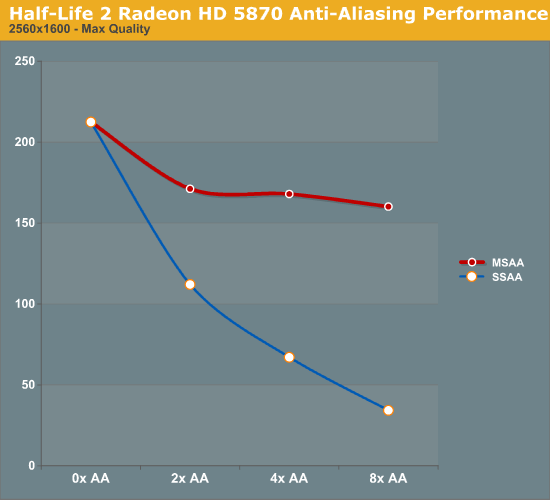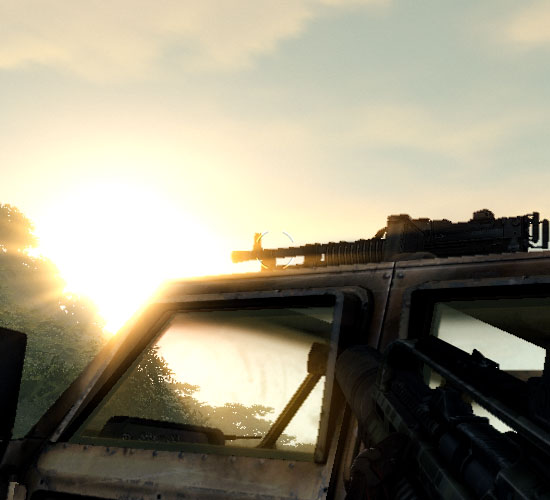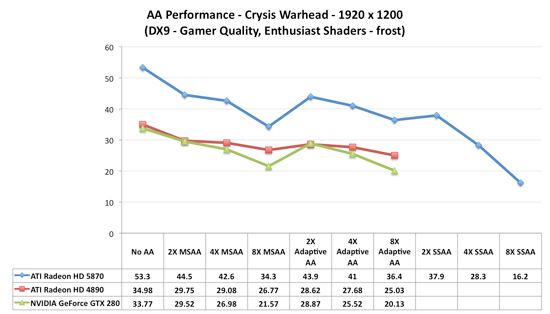AMD's Radeon HD 5870: Bringing About the Next Generation Of GPUs
by Ryan Smith on September 23, 2009 9:00 AM EST- Posted in
- GPUs
AA Image Quality & Performance
With HL2 unsuitable for use in assessing image quality, we will be using Crysis: Warhead for the task. Warhead has a great deal of foliage in parts of the game which creates an immense amount of aliasing, and along with the geometry of local objects forms a good test for anti-aliasing quality. Look in particular at the leaves both to the left and through the windshield, along with aliasing along the frame, windows, and mirror of the vehicle. We’d also like to note that since AMD’s SSAA modes do not work in DX10, this is done in DX9 mode instead.
|
AMD Radeon HD 5870
|
AMD Radeon HD 4870
|
NVIDIA GTX 280
|
| No AA | ||
| 2X MSAA | ||
| 4X MSAA | ||
| 8X MSAA | ||
| 2X MSAA +AAA | 2X MSAA +AAA | 2X MSAA + SSTr |
| 4X MSAA +AAA | 4X MSAA +AAA | 4X MSAA + SSTr |
| 8X MSAA +AAA | 8X MSAA +AAA | 8X MSAA + SSTr |
| 2X SSAA | ||
| 4X SSAA | ||
| 8X SSAA |
From an image quality perspective, very little has changed for AMD compared to the 4890. With MSAA and AAA modes enabled the quality is virtually identical. And while things are not identical when flipping between vendors (for whatever reason the sky brightness differs), the resulting image quality is still basically the same.
For AMD, the downside to this IQ test is that SSAA fails to break away from MSAA + AAA. We’ve previously established that SSAA is a superior (albeit brute force) method of anti-aliasing, but we have been unable to find any scene in any game that succinctly proves it. Shader aliasing should be the biggest difference, but in practice we can’t find any such aliasing in a DX9 game that would be obvious. Nor is Crysis Warhead benefitting from the extra texture sampling here.
From our testing, we’re left with the impression that for a MSAA + AAA (or MSAA + SSTr for NVIDIA) is just as good as SSAA for all practical purposes. Much as with the anisotropic filtering situation we know through technological proof that there is better method, but it just isn’t making a noticeable difference here. If nothing else this is good from a performance standpoint, as MSAA + AAA is not nearly as hard on performance as outright SSAA is. Perhaps SSAA is better suited for older games, particularly those locked at lower resolutions?
For our performance data, we have two cases. We will first look at HL2 on only the 5870, which we ran before realizing the quality problem with Source-engine games. We believe that the performance data is still correct in spite of the visual bug, and while we’re not going to use it as our only data, we will use it as an example of AA performance in an older title.

As a testament to the rendering power of the 5870, even at 2560x1600 and 8x SSAA, we still get a just-playable framerate on HL2. To put things in perspective, with 8x SSAA the game is being rendered at approximately 32MP, well over the size of even the largest possible single-card Eyefinity display.
Our second, larger performance test is Crysis: Warhead. Here we are testing the game on DX9 mode again at a resolution of 1920x1200. Since this is a look at the impact of AA on various architectures, we will limit this test to the 5870, the GTX 280, and the Radeon HD 4890. Our interest here is in performance relative to no anti-aliasing, and whether different architectures lose the same amount of performance or not.
Starting with the 5870, moving from 0x AA to 4x MSAA only incurs a 20% drop in performance, while 8x MSAA increases that drop to 35%, or 80% of the 4x MSAA performance. Interestingly, in spite of the heavy foliage in the scene, Adaptive AA has virtually no performance hit over regular MSAA, coming in at virtually the same results. SSAA is of course the big loser here, quickly dropping to unplayable levels. As we discussed earlier, the quality of SSAA is no better than MSAA + AAA here.
Moving on, we have the 4890. While the overall performance is lower, interestingly enough the drop in performance from MSAA is not quite as much, at only 17% for 4x MSAA and 25% for 8x MSAA. This makes the performance of 8x MSAA relative to 4x MSAA 92%. Once again the performance hit from enabling AAA is miniscule, at roughly 1 FPS.
Finally we have the GTX 280. The drop in performance here is in line with that of the 5870; 20% for 4x MSAA, 36% for 8x MSAA, with 8x MSAA offering 80% of the performance. Even enabling supersample transparency AA only knocks off 1 FPS, just like AAA under the 5870.
What this leaves us with are very curious results. On a percentage basis the 5870 is no better than the GTX 280, which isn’t an irrational thing to see, but it does worse than the 4890. At this point we don’t have a good explanation for the difference; perhaps it’s a product of early drivers or the early BIOS? It’s something that we’ll need to investigate at a later date.
Wrapping things up, as we discussed earlier AMD has been pitching the idea of better 8x MSAA performance in the 5870 compared to the 4800 series due to the extra cache. Although from a practical perspective we’re not sold on the idea that 8x MSAA is a big enough improvement to justify any performance hit, we can put to rest the idea that the 5870 is any better at 8x MSAA than prior cards. At least in Crysis: Warhead, we’re not seeing it.












327 Comments
View All Comments
SiliconDoc - Wednesday, September 30, 2009 - link
No, it's the fact you tell LIES, and always in ati's favor, and you got caught, over and over again.That is WHAT HAS HAPPENED.
Now you catch hold of your senses for a moment, and supposedly all the crap you spewed is "ok".
SiliconDoc - Friday, September 25, 2009 - link
Once again, all that matters to YOU, is YOUR games for PC, and ONLY top sellers, and only YOUR OPINION on PhysX.However, after you claimed only 2 games, you went on to bloviate about Havok.
Now you've avoided entirely that issue. Am I to assume, as you have apparently WISHED and thrown about, that HAVOK does not function on NVidia cards? NO QUITE THE CONTRARY !
--
What is REAL, is that NVidia runs Havok AND PhysX just fine, and not only that but ATI DOES NOT.
Now, instead of supporting BOTH, you have singled out your object of HATRED, and spewed your infantile rants, your put downs, your empty comparisons (mere statements), then DEMAND that I show PhysX is worthwhile, with "golden sellers". LOL
It has been 1.5 years or so since Aegia acquisition, and of course, game developers turning anything out in just 6 short months are considered miracle workers.
The real problem oif course for you is ATI does not support PhysX, and when a rouge coder made it happen, NVidia supported him, while ATI came in and crushed the poor fella.
So much for "competition", once again.
Now, I'd demand you show where HAVOK is worthwhile, EXCEPT I'm not the type of person that slams and reams and screams against " a percieved enemy company" just because "my favorite" isn't capable, and in that sense, my favorite IS CAPABLE.
Now, PhysX is awesome, it's great, it's the best there is, and that may or may not change, but as for now, NO OTHER demonstrations (you tube and otherwise) can match it.
That's just a sad fact for you, and with so many maintaining your biased and arrogant demand for anything else, we may have another case of VHS instead of BETA, which of course, you would heartily celebrate, no matter how long it takes to get there.
LOL
Yes, it is funny. It's just hilarious. A few months ago before Mirror's Edge and Anand falling in love with PhysX in it, admittedly, in the article he posted, we had the big screamers whining ZERO.
Well, now a few months later you are whining TWO.
Get ready to whine higher. Yes, you have read about the uptick in support ? LOL
You people are really something.
Oh, I know, CUDA is a big fat zero according to you, too.
(please pass along your thoughts to higher education universities here in the USA, and the federal government national lab research facilites. Thanks)
SiliconDoc - Thursday, September 24, 2009 - link
Yes, another excuse monger. So you basically admit the text is biased, and claim all readers should see the charts and go by those. LOLSo when the text is biased, as you admit, how is it that the rest, the very core of the review is not ? You won't explain that either.
Furthermore, the assumption that competition leads to something better in technology for videocards quicker, fails the basic test that in terms of technology, there is a limit to how fast it proceeds forward, since scientific breakthroughs must come, and often don't come, for instance, new energy technologies, still struggling after decades to make a breakthrough, with endless billions spent, and not much to show for it.
Same here with videocards, there is a LIMIT to the advancement speed, and competition won't be able to exceed that limit.
Furthermore, I NEVER said prices won't be driven down by competition, and you falsely asserted that notion to me.
I DID however say, ATI ALSO IS KNOWN FOR OVERPRICING. (or rather unknown by the red fans, huh, even said by omission to have NOT COMMITTED that "huge sin", that you all blame only Nvidia for doing.)
So you're just WRONG once again.
Begging the other guy to "not argue" then mischaracterizing a conclusion from just one of my statements, ignoring the points made that prove your buddy wrong period, and getting the body of your idea concerning COMPETITION incorrect due to technological and scientific constraints you fail to include, is no way to "argue" at all.
I sure wish there was someone who could take on my points, but so far none of you can. Every time you try, more errors in your thinking are easily exposed.
A MONOPOLY, in let's take for instance, the old OIL BARRONS, was not stagnant, and included major advances in search and extraction, as Standard Oil history clearly testifies to.
Once again, the "pat" cleche' is good for some things ( for instance competing drug stores, for example ), or other such things that don't involve inaccesible technology that has not been INVENTED yet.
The fact that your simpleton attitude failed to note such anomolies, is clearly evidence that once again, thinking "is not reuired" for people like you.
Once again, the rebuttal has failed.
kondor999 - Thursday, September 24, 2009 - link
This is just sad, and I'm no fanboy. I really wanted a 5870, but only with 100% more speed than a GTX285 - not a lousy 33%. Definitely not worth me upgrading, so I guess ATI saved me some money. I'm certain that my 3 GTX280's in Tri-SLI will destroy 2 5870's in CF - although with slightly less compatability (an important advantage for ATI, but not nearly enough).Moricon - Thursday, September 24, 2009 - link
I have been a regular at Tomshardware for a while now, nad keep coming back to Anandtech time and again to read reviews I have already read on other sites, and this one is by far the best I have read so far, (guru3d, toms, firing squad, and many others)The 5870 looks awesome, but from an upgrade point of view, I guess my system will not really benefit from moving on from E7200 @3.8ghz 4gb 1066, HD4870 @850mhz 4400mhz on 1680x1050.
Such a shame that i dont have a larger monitor at the moment or I would have jumped immediately.
Looks like the path is q9550 and 5870 and 1920x1200 monitor or larger to make sense, then might as well go i7, i5, where do you stop..
Well done ATI, well done! But if history follows the Nvidia 3xx chip will be mindblowing compared!
djc208 - Thursday, September 24, 2009 - link
I was most surprised at how far behind the now 2-generation old 3870 is now (at least on these high-end games). Guess my next upgrade (after a SSD) should be a 5850 once the frenzy dies away.JonnyDough - Thursday, September 24, 2009 - link
They could probably use a 1.5 GB card. :(mapesdhs - Wednesday, September 23, 2009 - link
Ryan, any chance you could run Viewperf or other pro-app benchmarks
please? Some professionals use consumer hardware as a cheap way of
obtaining reasonable performance in apps like Maya, 3DS Max, ProE,
etc., so it would most interesting to know how the 5870 behaves when
running such tests, how it compares to Quadro and FireGL cards.
Pro-series boards normally have better performance for ops such as
antialiases lines via different drivers and/or different internal
firmware optimisations. Someday I figure perhaps a consumer card will
be able to match a pro card purely by accident.
Ian.
AmdInside - Wednesday, September 23, 2009 - link
Sorry if this has already been asked but does the 5870 support audio over Display Port? I am holding out for a card that does such a thing. I know it does it for HDMI but also want it to do it for Display Port.VooDooAddict - Wednesday, September 23, 2009 - link
Been waiting for a single gaming class card that can power more then 2 displays for quite some time. (The more then 2 monitors not necessarily for gaming.)The fact that this performs a noticeable bit better then my existing 4870 512MB is a bonus.